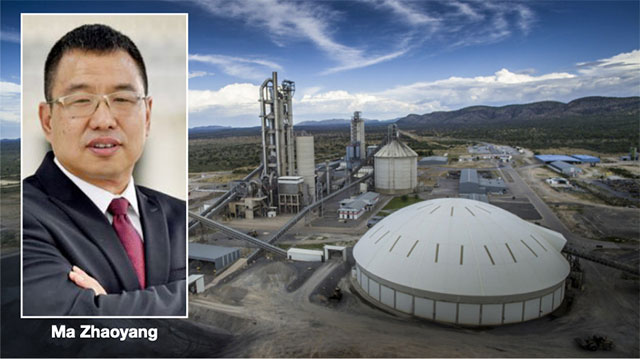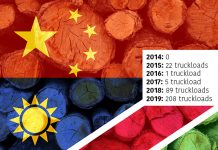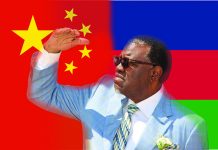
By Shinovene Immanuel and Lazarus Amukeshe | 05 April 2019
TWO Chinese companies could dominate Namibia’s cement industry if a Singapore-registered company buys Ohorongo Cement for about N$1,5 billion.
Singapore Stock Exchange-listed company International Cement Group Limited announced last month that it has agreed to acquire Ohorongo Cement, which operates a plant near Otavi in northern Namibia.
Even though the decision needs the Namibian Competition Commission’s approval, little has been reported on the transaction’s critical details.
However, the latest information obtained from the Singapore Stock Exchange shows that International Cement Group was listed only a few days before talks around buying Ohorongo were publicised.
Although The Namibian could not establish a direct link between this company and the Chinese government, key people in the transaction and other past dealings connect the firm to Beijing.
International Cement Group’s principal shareholders include Zeng Zhang, Pang Douglas, Ma Zhaoyang and Gim Huat, who all have links to China.
The prospective owners of Ohorongo claim to benefit from China’s state-funded infrastructure plan known as “The One Belt, One Road” initiative.
The initiative is the Chinese economic infrastructure development and investment agenda in railways, energy pipelines, highways and streamlined border crossings that will connect China to the world and areas that have resources and are of economic importance to that country.
Details about Ohorongo’s link to China are included in a 20 March report submitted by International Cement Group’s chairman and executive director, Ma.
It is not clear if Ma was name-dropping the Chinese link about the project, but his Bloomberg executive profile states that he was a professor at the Chinese state-funded North-western Polytechnical University, and also served on the West China Cement Limited board.
Ma’s report focused on questions posed by the Singapore Stock Exchange around Ohorongo’s ownership, management, asset base and profitability.
His report titled ‘Response to SGX-ST queries on proposed acquisition of a 100% equity interest of a company in Namibia’, states that the group’s deputy chief executive, Cao Jianshun, will manage Ohorongo after the proposed sale is finalised.
He referred to Namibia’s agreement with China, signed in Beijing in September last year, as one of their reasons for buying Ohorongo.
“The signing signifies China’s recognition of Namibia as a bilateral partner in a comprehensive strategic and cooperative partnership ahead of the Forum on China-Africa Cooperation (Focac).
“At Focac, China and Namibia signed bilateral cooperation documents to promote cooperation in the construction of road and rail infrastructure, and capacity-building,” Ma said.
Despite promises of benefiting from the grand-scale Chinese project, Ma said: “There are currently no plans for any significant cash/capital injection for Ohorongo Cement in the next few years”.
CASH FLOW
International Cement Group said it will pay around N$1,5 billion to acquire 100% of Schwenk Namibia, which owns around 70% in Ohorongo Cement.
Schwenk Namibia is wholly owned by Schwenk Zement International, which belongs to a German family.
The remaining 30% shares in Ohorongo Cement are held by Industrial Development Corporation of South Africa (14%), the Development Bank of Namibia (11%) and the Development Bank of Southern Africa (4%).
Schwenk Zement International funded the construction of Ohorongo through a loan that now stands at N$1,2 billion. This loan is paid back from dividends that Ohorongo pays to Schwenk Namibia.
Schwenk Namibia’s decision to sell to a Chinese-linked company contradicts their promise on their website of selling Ohorongo shares to Namibians.
“It is the intention of the company to be 100% Namibian owned, and to transfer shareholding gradually to Namibian institutions once the greenfield risks are over,” Ohorongo Cement says on its website.
International Cement Group said they will buy Schwenk Namibia with borrowed funds, and that negotiations to raise the money are currently underway.
Ohorongo sales revenue from 2016 to 2018 was about N$3,3 billion, while its profit between 2017 to 2018 was about N$900 million.
Schwenk Namibia’s net tangible assets – excluding trademarks and brands – was N$942 million in 2018.
International Cement Group estimates the market value of the plant to be around N$2 billion, meaning they will be buying Schwenk Namibia at a 36% discount.
Calculations by The Namibian show that should the sale be concluded, the maximum possible tax on the sale of the shareholding would be around N$400 million.
Ohorongo started raising red flags last year, complaining that the introduction of a second cement factory was not sustainable in the current financial environment.
The company, which at some point employed 600 workers, announced in August last year that it was cutting its workforce.
The introduction of another Chinese player in the cement sector could set up a possible monopoly in the construction industry as Namibia prepares to take out development loans from Beijing.
Development Bank of Namibia spokesperson Di-Anna Grobler told The Namibian yesterday that they were not offered the shares, but Schwenk Namibia informed the bank about the plan to sell its stake.
“The shares that are being sold are those of Schwenk Namibia, which owns shares in Ohorongo Cement,” she said.
According to her, “the briefing on the sale of the shares adhered to the agreement between several parties holding shares in Ohorongo Cement”.
DBN added that “the bank is still a shareholder in Ohorongo Cement, and will evaluate its position once it has comprehensively reviewed the situation and the strategy of the new shareholder,” she stated.






Thanks for sharing. I read many of your blog posts, cool, your blog is very good.
pin up azerbaycan yukle https://azerbaijancuisine.com/# pin up casino azerbaycan
pin up casino azerbaycan
pin-up oyunu: pin up apk yukle – pin up kazino
mexican rx online: mexican pharmacy – mexican pharmacy
https://northern-doctors.org/# mexico drug stores pharmacies
pharmacies in mexico that ship to usa: mexico drug stores pharmacies – mexican rx online
https://northern-doctors.org/# mexican pharmaceuticals online
mexican mail order pharmacies: mexican pharmacy – medicine in mexico pharmacies
mexico pharmacies prescription drugs: mexican pharmacy northern doctors – mexico drug stores pharmacies
https://northern-doctors.org/# mexican drugstore online
mexican pharmaceuticals online: Mexico pharmacy that ship to usa – mexico pharmacies prescription drugs
https://northern-doctors.org/# buying from online mexican pharmacy
pharmacies in mexico that ship to usa: buying from online mexican pharmacy – mexican pharmacy
medication from mexico pharmacy northern doctors mexico pharmacies prescription drugs
mexican pharmacy: mexican pharmacy – mexican border pharmacies shipping to usa
http://northern-doctors.org/# mexican pharmaceuticals online
medication from mexico pharmacy: mexican pharmacy northern doctors – mexico drug stores pharmacies
https://northern-doctors.org/# mexican drugstore online
mexican online pharmacies prescription drugs: mexican pharmacy – mexican online pharmacies prescription drugs
п»їbest mexican online pharmacies: mexican northern doctors – medicine in mexico pharmacies
https://northern-doctors.org/# mexican rx online
mexico drug stores pharmacies mexican pharmacy northern doctors medicine in mexico pharmacies
reputable mexican pharmacies online: northern doctors pharmacy – mexican drugstore online
http://northern-doctors.org/# mexican online pharmacies prescription drugs
medicine in mexico pharmacies: mexican pharmacy – medication from mexico pharmacy
reputable mexican pharmacies online: northern doctors pharmacy – reputable mexican pharmacies online
http://northern-doctors.org/# mexico pharmacy
medicine in mexico pharmacies: mexican pharmacy northern doctors – mexican rx online
buying prescription drugs in mexico mexican pharmacy online mexican mail order pharmacies
https://northern-doctors.org/# best online pharmacies in mexico
reputable mexican pharmacies online: mexican northern doctors – mexican drugstore online
medication from mexico pharmacy: mexican northern doctors – mexico pharmacies prescription drugs
http://northern-doctors.org/# purple pharmacy mexico price list
purple pharmacy mexico price list: northern doctors pharmacy – mexican rx online
https://northern-doctors.org/# buying prescription drugs in mexico online
mexico pharmacy: Mexico pharmacy that ship to usa – mexican pharmaceuticals online
medication from mexico pharmacy mexican northern doctors purple pharmacy mexico price list
best online pharmacies in mexico: mexican northern doctors – mexican pharmaceuticals online
http://northern-doctors.org/# medication from mexico pharmacy
buying prescription drugs in mexico online: northern doctors – mexican border pharmacies shipping to usa
https://northern-doctors.org/# medicine in mexico pharmacies
buying from online mexican pharmacy: mexican drugstore online – mexico drug stores pharmacies
pharmacies in mexico that ship to usa: mexican pharmacy northern doctors – pharmacies in mexico that ship to usa
https://northern-doctors.org/# mexico pharmacies prescription drugs
buying prescription drugs in mexico online: mexican mail order pharmacies – mexican mail order pharmacies
purple pharmacy mexico price list mexican northern doctors pharmacies in mexico that ship to usa
mexican pharmacy: northern doctors – mexican pharmacy
http://northern-doctors.org/# pharmacies in mexico that ship to usa
buying prescription drugs in mexico: mexican pharmacy – mexican mail order pharmacies
https://northern-doctors.org/# mexican pharmacy
mexican pharmacy: mexico pharmacy – pharmacies in mexico that ship to usa
http://northern-doctors.org/# mexican border pharmacies shipping to usa
buying prescription drugs in mexico: Mexico pharmacy that ship to usa – purple pharmacy mexico price list
https://northern-doctors.org/# best online pharmacies in mexico
mexico pharmacies prescription drugs mexican pharmacy online mexican drugstore online
http://northern-doctors.org/# medication from mexico pharmacy
buying prescription drugs in mexico: mexican pharmacy northern doctors – buying prescription drugs in mexico
best online pharmacies in mexico: mexican pharmacy – medication from mexico pharmacy
https://northern-doctors.org/# reputable mexican pharmacies online
buying prescription drugs in mexico online: Mexico pharmacy that ship to usa – mexico drug stores pharmacies
mexican mail order pharmacies: buying from online mexican pharmacy – mexican rx online
https://cmqpharma.online/# medicine in mexico pharmacies
mexico drug stores pharmacies
purple pharmacy mexico price list: cmq pharma mexican pharmacy – best online pharmacies in mexico
п»їbest mexican online pharmacies mexican pharmacy buying prescription drugs in mexico
purple pharmacy mexico price list cmq pharma mexico pharmacies prescription drugs
mexico drug stores pharmacies online mexican pharmacy mexican online pharmacies prescription drugs
purple pharmacy mexico price list
https://cmqpharma.com/# purple pharmacy mexico price list
mexican drugstore online
purple pharmacy mexico price list mexican pharmacy online purple pharmacy mexico price list
mexican pharmacy mexican pharmacy online mexico drug stores pharmacies
buying prescription drugs in mexico cmq pharma buying prescription drugs in mexico online
buying prescription drugs in mexico mexican online pharmacy mexican pharmaceuticals online
buying from online mexican pharmacy mexico drug stores pharmacies mexican border pharmacies shipping to usa
mexican mail order pharmacies mexican pharmacy reputable mexican pharmacies online
mexico drug stores pharmacies: mexican online pharmacy – mexican drugstore online
п»їbest mexican online pharmacies
https://cmqpharma.online/# buying prescription drugs in mexico online
mexican online pharmacies prescription drugs
mexico pharmacy: cmqpharma.com – medicine in mexico pharmacies
mexican pharmaceuticals online
https://cmqpharma.online/# п»їbest mexican online pharmacies
mexican border pharmacies shipping to usa
mexican rx online mexico pharmacies prescription drugs mexico pharmacy
https://foruspharma.com/# п»їbest mexican online pharmacies
medicine in mexico pharmacies: buying prescription drugs in mexico – buying prescription drugs in mexico online
mexico pharmacy: mexican pharmacy – mexican pharmacy
mexican border pharmacies shipping to usa mexican pharmacy п»їbest mexican online pharmacies
safe reliable canadian pharmacy: legit canadian pharmacy – best mail order pharmacy canada
canadian pharmacy in canada: canada drugs – canadian pharmacy ltd
http://canadapharmast.com/# cheapest pharmacy canada
top 10 online pharmacy in india indianpharmacy com top 10 online pharmacy in india
Online medicine order: indian pharmacy – best india pharmacy
buy prescription drugs from canada cheap: my canadian pharmacy review – canadian pharmacy prices
northwest pharmacy canada: vipps approved canadian online pharmacy – canadian pharmacy drugs online
buying from online mexican pharmacy pharmacies in mexico that ship to usa mexican rx online
https://canadapharmast.com/# canadian compounding pharmacy
certified canadian international pharmacy: canadian medications – canadian pharmacies that deliver to the us
india pharmacy: indian pharmacy online – best online pharmacy india
http://clomiddelivery.pro/# can i order clomid pill
doxycycline 50 mg coupon: can i buy 40mg doxycycline online – doxycycline 250 mg
https://ciprodelivery.pro/# cipro
http://doxycyclinedelivery.pro/# purchase doxycycline online
Paxlovid buy online: paxlovid buy – paxlovid covid
doxycycline prescription: doxycycline order online canada – doxycycline 7.5 mg
https://ciprodelivery.pro/# cipro online no prescription in the usa
https://clomiddelivery.pro/# generic clomid pills
cipro 500mg best prices: ciprofloxacin 500mg buy online – where to buy cipro online
https://paxloviddelivery.pro/# Paxlovid over the counter
https://clomiddelivery.pro/# clomid without insurance
can i get cheap clomid pills: cheap clomid prices – where to get generic clomid
http://ciprodelivery.pro/# cipro
clomid medication: can i order clomid for sale – how to buy generic clomid for sale
purchase doxycycline without prescription: doxycycline usa pharmacy – vibramycin 100 mg